Cricket
From Wikipedia, the free encyclopedia
This article is about the sport. For the insect, see Cricket (insect). For other uses, see Cricket (disambiguation).
"Cricketer" redirects here. For other uses, see Cricketer (disambiguation).
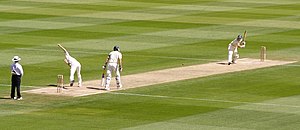
A bowler bowling to a batsman. The paler strip is the cricket pitch. The two sets of three wooden stumps on the pitch are the wickets. The two white lines are the creases.
| |
| Highest governing body | International Cricket Council |
|---|---|
| First played | 18th century (modern version – see history) |
| Characteristics | |
| Contact | No |
| Team members | 11 players per side (substitutes permitted in some circumstances) |
| Mixed gender | yes, separate competitions |
| Type | team sport, bat-and-ball |
| Equipment | cricket ball, cricket bat, wicket (stumps, bails), various protective equipment |
| Venue | cricket field |
| Presence | |
| Country or region | Australasia, United Kingdom, Indian subcontinent, Southern Africa, Caribbean |
| Olympic | No (1900 Summer Olympics only) |
Cricket is a bat-and-ball game played between two teams of eleven players on a cricket field, at the centre of which is a rectangular 22-yard-long pitch with a wicket (a set of three wooden stumps) at each end. One team bats, attempting to score as many runs as possible, whilst their opponents field. Each phase of play is called an innings. After either ten batsmen have been dismissed or a fixed number of overs have been completed, the innings ends and the two teams then swap roles. The winning team is the one that scores the most runs, including any extras gained, during their innings.
At the start of each game, two batsmen and eleven fielders enter the field of play. The play begins when a member of the fielding team, known as the bowler, delivers the ball from one end of the pitch to the other, towards the wicket at that end, in front of which stands one of the batsmen, known as the striker. The striker "takes guard" on a crease drawn on the pitch four feet in front of the wicket. His role is to prevent the ball from hitting the stumps by use of his bat, and simultaneously to strike it well enough to score runs. The other batsman, known as the non-striker, waits at the opposite end of the pitch near the bowler. A dismissed batsman must leave the field, and a teammate replaces him. The bowler's objectives are to prevent the scoring of runs and to dismiss the batsman. An over is a set of six deliveries bowled by the same bowler. The next over is bowled from the other end of the pitch by a different bowler.
The most common forms of dismissal are bowled, when the bowler hits the stumps directly with the ball; leg before wicket, when the batsman prevents the ball from hitting the stumps with his body instead of his bat; and caught, when the batsman hits the ball into the air and it is intercepted by a fielder before touching the ground. Runs are scored by two main methods: either by hitting the ball hard enough for it to cross the boundary, or by the two batsmen swapping ends by each simultaneously running the length of the pitch in opposite directions whilst the fielders are retrieving the ball. If a fielder retrieves the ball quickly enough to put down the wicket with a batsman not having reached the crease at that end of the pitch, that batsman is dismissed (a run-out occurs). Adjudication is performed on the field by two umpires.
The laws of cricket are maintained by the International Cricket Council (ICC) and the Marylebone Cricket Club (MCC). There are various formats ranging from Twenty20, played over a few hours with each team having a single innings of 20 overs (i.e. 120 deliveries), to Test cricket, played over five days with unlimited overs and the teams playing two innings apiece. Traditionally cricketers play in all-white kit, but in limited overs cricket they wear club or team colours. In addition to the basic kit, some players wear protective gear to prevent injury caused by the ball, which is a hard, solid object made of compressed leather enclosing a cork core.
Although cricket's origins are uncertain, it is first recorded in south-east England in the 16th century. It spread globally with the expansion of the British Empire, leading to the first international matches in the mid-19th century. ICC, the game's governing body, has over 100 members, ten of which are full members who play Test cricket. The sport is followed primarily in Australasia, Britain, the Indian subcontinent, southern Africa and the West Indies. Women's cricket, which is organised and played separately, has also achieved international standard.
Contents
[hide]Etymology
A number of words have been suggested as sources for the term "cricket". In the earliest definite reference to the sport in 1598 it is called creckett.[1] One possible source for the name is the Old English cricc or cryce meaning a crutch or staff.[2] In Samuel Johnson's Dictionary, he derived cricket from "cryce, Saxon, a stick".[3] In Old French, the word criquet seems to have meant a kind of club or stick.[2]
Given the strong medieval trade connections between south-east England and the County of Flanders when the latter belonged to the Duchy of Burgundy, the name may have been derived from the Middle Dutch (in use in Flanders at the time) krick(-e), meaning a stick (crook).[2] Another possible source is the Middle Dutch word krickstoel, meaning a long low stool used for kneeling in church and which resembled the long low wicket with two stumps used in early cricket.[4]According to Heiner Gillmeister, a European language expert of Bonn University, "cricket" derives from the Middle Dutch phrase for hockey, met de (krik ket)sen (i.e., "with the stick chase").[5] Dr Gillmeister believes that not only the name but the sport itself is of Flemish origin.[6]
History
Main article: History of cricket
Cricket can definitely be traced back to Tudor times in early 16th-century England though there have been a number of claims, many of them spurious and/or lacking evidence, supporting earlier dates from 1301. The earliest definite reference to cricket being played comes from evidence given at a 1598 court case which mentions that "creckett" (sic) was played on common land in Guildford around 1550. The court in Guildford heard on Monday, 17 January 1597 (Julian date, equating to the year 1598 in the Gregorian calendar) from a 59-year-old coroner, John Derrick, who gave witness that when he was a scholar at the "Free School at Guildford", fifty years earlier, "hee and diverse of his fellows did runne and play [on the common land] at creckett and other plaies."[3][7]
It is believed that cricket was originally a children's game but references in 1611[3] indicate that adults had started playing it and the earliest known organised inter-parish or village cricket match was played around that time.[8] In 1624, a player called Jasper Vinall died after he was struck on the head during a match between two parish teams in Sussex.[9] During the 17th century, numerous references indicate the growth of cricket in the south-east of England. By the end of the century, it had become an organised activity being played for high stakes and it is believed that the first professionals appeared in the years following the Restoration in 1660. A newspaper report survives of "a great cricket match" with eleven players a side that was played for high stakes in Sussex in 1697, and this is the earliest known reference to a cricket match of such importance.[10]
The game underwent major development in the 18th century. Betting played a key part in that development with rich patrons forming their own "select XIs". Cricket was prominent in London as early as 1707 and, in the middle years of the century, large crowds flocked to matches on the Artillery Ground in Finsbury. The single wicket form of the sport attracted huge crowds and wagers to match, its popularity peaking in the 1748 season. Bowling underwent an evolution around 1760 when bowlers began to pitch the ball instead of rolling or skimming it towards the batsman. This caused a revolution in bat design because, to deal with the bouncing ball, it was necessary to introduce the modern straight bat in place of the old "hockey stick" shape. The Hambledon Club was founded in the 1760s and, for the next twenty years until the formation of Marylebone Cricket Club (MCC) and the opening of Lord's Old Ground in 1787, Hambledon was both the game's greatest club and its focal point. MCC quickly became the sport's premier club and the custodian of the Laws of cricket. New Laws introduced in the latter part of the 18th century included the three stump wicket and leg before wicket (lbw).
The 19th century saw underarm bowling superseded by first roundarm and then overarm bowling. Both developments were controversial. Organisation of the game at county level led to the creation of the county clubs, starting with Sussex in 1839, which ultimately formed the official County Championship in 1890. Meanwhile, the British Empire had been instrumental in spreading the game overseas and by the middle of the 19th century it had become well established in India, North America, the Caribbean, South Africa, Australia and New Zealand. In 1844, the first-ever international match took place between the United States and Canada. In 1859, a team of English players went to North America on the first overseas tour.
The first Australian team to tour overseas was a team of Aboriginal stockmen who travelled to England in 1868 to play matches against county teams.[11] In 1862, an English team made the first tour of Australia. The most famous player of the 19th century was W. G. Grace, who started his long and influential career in 1865.
In 1876–77, an England team took part in what was retrospectively recognised as the first-ever Test match at the Melbourne Cricket Ground against Australia. The rivalry between England and Australia gave birth to The Ashes in 1882 and this has remained Test cricket's most famous contest. Test cricket began to expand in 1888–89 when South Africa played England.
The last two decades before the First World War have been called the "Golden Age of cricket". It is a nostalgic name prompted by the collective sense of loss resulting from the war, but the period did produce some great players and memorable matches, especially as organised competition at county and Test level developed.
The inter-war years were dominated by one player: Australia's Don Bradman, statistically the greatest batsman of all time. Test cricket continued to expand during the 20th century with the addition of the West Indies, India and New Zealand before the Second World War and then Pakistan, Sri Lanka, Zimbabwe and Bangladesh in the post-war period. South Africa was banned from international cricket from 1970 to 1992 as part of the apartheid boycott.
Cricket entered a new era in 1963 when English counties introduced the limited overs variant. As it was sure to produce a result, limited overs cricket was lucrative and the number of matches increased. The first Limited Overs International was played in 1971. The governing International Cricket Council (ICC) saw its potential and staged the first limited overs Cricket World Cup in 1975. In the 21st century, a new limited overs form, Twenty20, has made an immediate impact.
While some English team games like hockey and football became international games, played all over the world, cricket remained a colonial game, limited to those countries that had once been a part of the British empire. The pre-industrial oddness of cricket made it a hard game to export. It took root only in countries that the British conquered and ruled. In these colonies cricket was established as a popular sport either by white settlers or by local elites who wanted to copy the habits of their colonial masters, as in India.
Rules and game-play
Main article: Laws of cricket
Cricket is a bat and ball game, played between two teams of eleven players each.[12][13] One team bats, attempting to score runs, while the other bowls and fields the ball, attempting to restrict the scoring and dismiss the batsmen. The objective of the game is for a team to score more runs than its opponent. In some forms of cricket, it is also necessary to dismiss the opposition in order to win the match, which would otherwise be drawn.
Format of the game
A cricket match is divided into periods called innings (which ends with "s" in both singular and plural form). It is decided before the match whether the teams will have one innings or two innings each. During an innings one team fields and the other bats. The two teams switch between fielding and batting after each innings. All eleven members of the fielding team take the field, but only two members of the batting team (two batsmen) are on the field at any given time. The order of batsmen is usually announced just before the match, but it can be varied.
A coin toss is held by the team captains (who are also players) just before the match starts: the winner decides whether to bat or field first.
The cricket field is usually circular or oval in shape, with a rectangular pitch at the centre. The edge of the playing field is marked with a boundary, which could be a fence, part of the stands, a rope or a painted line.
At each end of the pitch is a wooden target called a wicket; the two wickets are placed 22 yards (20 m) apart. The pitch is marked with painted lines: a bowling crease in line with the wicket, and a batting or popping crease four feet (122 cm) in front of it. The wicket is made of three vertical stumps supporting two small horizontal bails. A wicket is put down if at least one bail is dislodged, or one stump is knocked down (usually by the ball, but also if the batsman does it with his body, clothing or equipment). This is also described as breaking, knocking down, or hitting the wicket – though if the ball hits the wicket but does not dislodge a bail or stump then it is not considered to be down.
At any instant each batsman "owns" a particular wicket (usually the one closer to him) and, except when actually batting, is safe when he is in his ground. This means that at least one part of his body or bat is touching the ground behind the popping crease. If his wicket is put down while the ball is live and he is out of his ground then he is dismissed, but the other batsman is safe.[14]
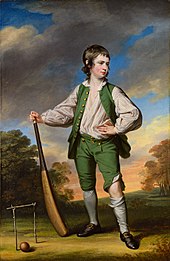
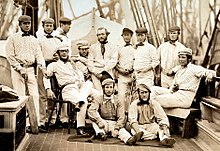
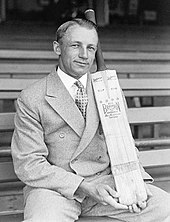
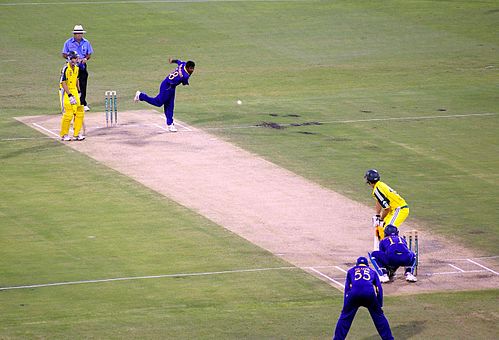




No comments:
Post a Comment